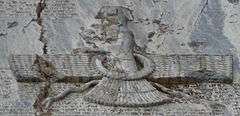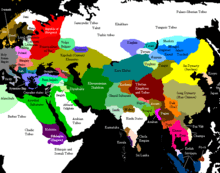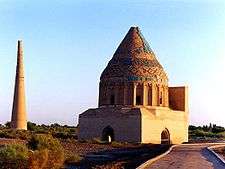Khwarazmian dynasty
The Khwarazmian dynasty (English: /kwəˈræzmiən/[5]) was a Persianate[6][7][8] Sunni Muslim dynasty of Turkic mamluk origin.[9][10] The dynasty ruled large parts of present-day Central Asia, Afghanistan, and Iran in the approximate period of 1077 to 1231, first as vassals of the Seljuqs[11] and the Qara-Khitan,[12] and later as independent rulers, up until the Mongol invasion of Khwarezmia in the 13th century. It's estimated that the dynasty spanned over an area from 2.3[13] to 3.6[14] million square kilometers.
Khwarazmian Empire خوارزمشاهیان Khwārazmshāhiyān | |||||||||||
|---|---|---|---|---|---|---|---|---|---|---|---|
| 1077–1231 | |||||||||||
Khwarezmid Empire's Area | |||||||||||
| Capital | Gurganj (1077–1212) Samarkand (1212–1220) Ghazna (1220–1221) Tabriz (1225–1231) | ||||||||||
| Common languages | Persian[1] Kipchak Turkic[2] | ||||||||||
| Religion | Sunni Islam | ||||||||||
| Government | Oligarchy | ||||||||||
| Khwarazm-Shah or Sultan | |||||||||||
• 1077–1096/7 | Anushtigin Gharchai | ||||||||||
• 1220–1231 | Jalal ad-Din Mingburnu | ||||||||||
| Historical era | Medieval | ||||||||||
• Established | 1077 | ||||||||||
• Mongol conquest of Khwarezmia | 1219-1221 | ||||||||||
| 1230 | |||||||||||
• Disestablished | 1231 | ||||||||||
| Area | |||||||||||
| 1210 est.[3] or | 2,300,000 km2 (890,000 sq mi) | ||||||||||
| 1218 est.[4] | 3,600,000 km2 (1,400,000 sq mi) | ||||||||||
| |||||||||||
The dynasty was founded by commander Anush Tigin Gharchai, a former Turkic slave of the Seljuq sultans, who was appointed as governor of Khwarezm. His son, Qutb ad-Din Muhammad I, became the first hereditary Shah of Khwarezm.[15] Anush Tigin may have belonged to either the Begdili tribe of the Oghuz Turks[16] or to Chigil, Khalaj, Qipchaq, Qangly, or Uyghur Turks.[17]
Names
It was also known as the Khwarezmid dynasty, the Anushtegin dynasty, the dynasty of Khwarazm Shahs (خوارزمشاه), and other spelling variants. In modern Persian it is known as خوارزمشاهیان.
| History of the Turkic peoples pre-14th century |
|---|
History of the Turkic peoples |
| Tiele people |
| Göktürks |
|
| Khazar Khaganate 618–1048 |
| Xueyantuo 628–646 |
| Kangar union 659–750 |
| Turk Shahi 665-850 |
| Türgesh Khaganate 699–766 |
| Kimek confederation 743–1035 |
| Uyghur Khaganate 744–840 |
| Oghuz Yabgu State 750–1055 |
| Karluk Yabgu State 756–940 |
| Kara-Khanid Khanate 840–1212 |
| Ganzhou Uyghur Kingdom 848–1036 |
| Qocho 856–1335 |
| Pecheneg Khanates 860–1091 |
| Ghaznavid Empire 963–1186 |
| Seljuk Empire 1037–1194 |
| Cumania 1067–1239 |
| Khwarazmian Empire 1077–1231 |
| Kerait Khanate 11th century–13th century |
| Delhi Sultanate 1206–1526 |
| Qarlughid Kingdom 1224–1266 |
| Golden Horde 1240s–1502 |
| Mamluk Sultanate (Cairo) 1250–1517 |
 Faravahar background | ||||||||||||||||||||||||||||||||||||||||||||||||||||||||||||||||||||||
| History of Greater Iran | ||||||||||||||||||||||||||||||||||||||||||||||||||||||||||||||||||||||
|---|---|---|---|---|---|---|---|---|---|---|---|---|---|---|---|---|---|---|---|---|---|---|---|---|---|---|---|---|---|---|---|---|---|---|---|---|---|---|---|---|---|---|---|---|---|---|---|---|---|---|---|---|---|---|---|---|---|---|---|---|---|---|---|---|---|---|---|---|---|---|
|
Pre-Islamic BCE / BC
|
||||||||||||||||||||||||||||||||||||||||||||||||||||||||||||||||||||||
|
||||||||||||||||||||||||||||||||||||||||||||||||||||||||||||||||||||||
Part of a series on the |
|---|
| History of Turkmenistan |
 |
| Periods |
|
Antiquity
|
|
Early modern history |
| Related historical names of the region |
|
|
| History of Uzbekistan |
|---|
|
|
|
History
The date of the founding of the Khwarazmian dynasty remains debatable. During a revolt in 1017, Khwarezmian rebels murdered Abu'l-Abbas Ma'mun and his wife, Hurra-ji, sister of the Ghaznavid sultan Mahmud.[18] In response, Mahmud invaded and occupied the region of Khwarezm, which included Nasa and the ribat of Farawa.[19] As a result, Khwarezm became a province of the Ghaznavid Empire from 1017 to 1034. In 1077, the governorship of the province, which since 1042/1043 belonged to the Seljuqs, fell into the hands of Anush Tigin Gharchai, a former Turkic slave of the Seljuq sultan. In 1141, the Seljuq Sultan Ahmed Sanjar was defeated by the Qara Khitai at the battle of Qatwan, and Anush Tigin's grandson Ala ad-Din Atsiz became a vassal to Yelü Dashi of the Qara Khitan.[20]
Sultan Ahmed Sanjar died in 1156. As the Seljuk state fell into chaos, the Khwarezm-Shahs expanded their territories southward. In 1194, the last Sultan of the Great Seljuq Empire, Toghrul III, was defeated and killed by the Khwarezm ruler Ala ad-Din Tekish, who conquered parts of Khorasan and western Iran. In 1200, Tekish died and was succeeded by his son, Ala ad-Din Muhammad, who initiated a conflict with the Ghurids and was defeated by them at Amu Darya (1204).[21] Following the sack of Khwarizm, Muhammad appealed for aid from his suzerain, the Qara Khitai who sent him an army.[22] With this reinforcement, Muhammad won a victory over the Ghorids at Hezarasp (1204) and forced them out of Khwarizm.
Ala ad-Din Muhammad's alliance with his suzerain was short-lived. He again initiated a conflict, this time with the aid of the Kara-Khanids, and defeated a Qara-Khitai army at Talas (1210),[23] but allowed Samarkand (1210) to be occupied by the Qara-Khitai.[24] He overthrew the Karakhanids (1212)[25] and Ghurids (1215). In 1212, he shifted his capital from Gurganj to Samarkand. Thus incorporating nearly the whole of Transoxania and present-day Afghanistan into his empire, which after further conquests in western Persia (by 1217) stretched from the Syr Darya to the Zagros Mountains, and from the northern parts of the Hindu Kush to the Caspian Sea. By 1218, the empire had a population of 5 million people.[26]
Mongol invasion and collapse of Khwarezmia
In 1218, Genghis Khan sent a trade mission to the state, but at the town of Otrar the governor, suspecting the Khan's ambassadors to be spies, confiscated their goods and executed them. Genghis Khan demanded reparations, which the Shah refused to pay. Genghis retaliated with a force of 200,000 men, launching a multi-pronged invasion. In February 1220 the Mongolian army crossed the Syr Darya. The Mongols stormed Bukhara, Gurganj and the Khwarezmid capital Samarkand. The Shah fled and died some weeks later on an island in the Caspian Sea.
The son of Ala ad-Din Muhammad, Jalal ad-Din Mingburnu, became the new Sultan (he rejected the title Shah). He attempted to flee to India, but the Mongols caught up with him before he got there, and he was defeated at the Battle of Indus. He escaped and sought asylum in the Sultanate of Delhi. Iltumish however denied this to him in deference to the relationship with the Abbasid caliphs. Returning to Persia, he gathered an army and re-established a kingdom. He never consolidated his power, however, spending the rest of his days struggling against the Mongols, the Seljuks of Rum, and pretenders to his own throne. He lost his power over Persia in a battle against the Mongols in the Alborz Mountains. Escaping to the Caucasus, he captured Azerbaijan in 1225, setting up his capital at Tabriz. In 1226 he attacked Georgia and sacked Tbilisi. Following on through the Armenian highlands he clashed with the Ayyubids, capturing the town Ahlat along the western shores of the Lake Van, who sought the aid of the Seljuk Sultanate of Rûm. Sultan Kayqubad I defeated him at Arzinjan on the Upper Euphrates at the Battle of Yassıçemen in 1230. He escaped to Diyarbakir, while the Mongols conquered Azerbaijan in the ensuing confusion. He was murdered in 1231 by Kurdish highwaymen.[27]
Mercenaries

Though the Mongols had destroyed the Khwarezmian Empire in 1220, many Khwarezmians survived by working as mercenaries in northern Iraq. Sultan Jalal ad-Din's followers remained loyal to him even after his death in 1231, and raided the Seljuk lands of Jazira and Syria for the next several years, calling themselves the Khwarezmiyya. Ayyubid Sultan as-Salih Ayyub, in Egypt, later hired their services against his uncle as-Salih Ismail. The Khwarezmiyya, heading south from Iraq towards Egypt, invaded Crusader-held Jerusalem along the way, on 11 July 1244. The city's citadel, the Tower of David, surrendered on 23 August, and the Christian population of the city was expelled. This triggered a call from Europe for the Seventh Crusade, but the Crusaders would never again be successful in retaking Jerusalem. After being conquered by the Khwarezmian forces, the city stayed under Muslim control until 1917, when it was taken from the Ottomans by the British.
After taking Jerusalem, the Khwarezmian forces continued south, and on 17 October fought on the side of the Ayyubids at the Battle of La Forbie, as the Crusaders used to call Harbiyah, a village northeast of Gaza, destroying the remains of the Crusader army there, with some 1,200 knights killed. It was the largest battle involving the Crusaders since the Battle of the Horns of Hattin in 1187.[28]
The remaining Muslim Khwarezmians served in Egypt as Mamluk mercenaries until they were finally beaten by al-Mansur Ibrahim some years later.
Khwarezmi war captives assimilated into the Mongols, forming the modern Mongolian clan Sartuul.
Rulers of Khwarezm
Mamunid Governors of Khwarezm
| Titular Name | Personal Name | Reign |
|---|---|---|
| Amir امیر |
Abu'l-Ali Ma'mun ibn Muhammad ابو علی المأمون ابن محمد |
995–997 C.E. |
| Amir امیر |
Abu'l-Hasan Ali ibn Ma'mun ابو الحسن علی ابن المأمون |
997–1008/9 C.E. |
| Amir امیر |
Abu'l-Abbas Ma'mun ibn Ma'mun ابو العباس مأمون ابن المأمون |
1008/9–1017 C.E. |
| Amir امیر |
Abu'l-Harith Muhammad ibn Ali ابو الحارث محمد ابن علی |
1017 C.E. |
| Absorbed into the Ghaznavid Empire by Mahmud ibn Sebuktigin;he made Altun Tash its governor. | ||
- Blue Row Signifies vassalage of Samanid Empire.
- Green Rows Signify vassalage of Ghaznavid Empire.
Altun-Tashid Governors of Khwarezm
| Titular Name | Personal Name | Reign |
|---|---|---|
| Amir امیر |
Abu Sa'id Altun-Tash ابو سعید التون طاش |
1017–1032 C.E. |
| Amir امیر |
Harun ibn Altun-Tash ہارون ابن التون طاش |
1032–1034 C.E. |
| Amir امیر |
Ismail Khandan ibn Altun-Tash اسماعیل خاندان ابن التون طاش |
1034–1041 C.E. |
| Re-conquest by Ghaznavid Empire under Mas'ud ibn Mahmud ibn Sebuktigin who sent his general Shah Malik, the Oghuz Turk | ||
- Green Rows Signify Ghaznavid Empire rule.
Non-dynastic Governor
| Titular Name | Personal Name | Reign |
|---|---|---|
| Amir امیر Abul-Fawaris أبو الفوارس |
Shah-Malik ibn Ali شاہ ملک ابن علی |
1041–1042 C.E. |
| Conquest of Khwarezm by Tughril Beg and Chaghri Beg of the Seljuq Empire. | ||
- Green Row Signifies rule of Ghaznavid Empire.
Governor Anushtigin
| Title | Personal Name | Reign |
|---|---|---|
| Shihna ؟ |
Anush Tigin Gharchai أنوش طگین غارچائی |
1077–1097 C.E. |
- Purple Row Signifies rule of Seljuq Empire.
Non-dynastic Governor
| Title | Personal Name | Reign |
|---|---|---|
| Shihna ؟ |
Ekinchi ibn Qochqar ایکینچی بن قوچار |
1097 C.E. |
- Purple Row Signifies rule of Seljuq Empire.
Anushtiginid Shahs
| Titular Name | Personal Name | Reign | ||
|---|---|---|---|---|
| Shah شاہ Qutb ad-Din Abul-Fath قطب الدین ابو الفتح |
Arslan Tigin Muhammad ibn Anush Tigin ارسلان طگین محمد ابن أنوش طگین |
1097–1127/28 C.E. | ||
| Shah شاہ Ala al-Dunya wa al-Din Abul-Muzaffar علاء الدنیا و الدین، ابو المظفر |
Qizil Arslan Atsiz ibn Muhammad قزل ارسلان أتسز بن محمد |
1127–1156 C.E. | ||
| Shah شاہ Taj al-Dunya wa al-Din Abul-Fath تاج الدنیا و الدین، ابو الفتح |
Il-Arslan ibn Qizil Arslan Atsiz ایل ارسلان بن قزل ارسلان أتسز |
1156–1172 C.E. | ||
| Shah شاہ Ala al-Dunya wa al-Din Abul-Muzaffar علاء الدنیا و الدین، ابو المظفر |
Tekish ibn Il-Arslan تکش بن ایل ارسلان |
1172–1200 C.E. | ||
| Shah شاہ Jalal al-Dunya wa al-Din Abul-Qasim جلال الدنیا و الدین، ابو القاسم |
Mahmud Sultan Shah ibn Il-Arslan محمود سلطان شاہ ابن ایل ارسلان Initially under regency of Turkan Khatun, his mother. He was a younger half-brother and rival of Tekish in Upper Khurasan |
1172–1193 C.E. | ||
| Shah شاہ Ala al-Dunya wa al-Din Abul-Fath علاء الدنیا و الدین، ابو الفتح |
Muhammad ibn Tekish محمد بن تکش |
1200–1220 C.E. | ||
| Genghis Khan چنگیز خان Genghis Khan invades Khwarezmia forcing Muhammad ibn Tekish to flee along with his son to an island in the Caspian Sea where he would die of pleurisy. | ||||
| Jalal al-Dunya wa al-Din Abul-Muzaffar جلال الدنیا و الدین، ابو المظفر |
Mingburnu ibn Muhammad مِنکُبِرنی ابن محمد |
1220–1231 C.E. | ||
| Establishment of Mongol Ilkhanate | ||||
- Purple Row Signifies Seljuq Empire rule.
- Pink Row Signifies suzerainty shifting between Qara-Khitai & Seljuq Empire
- Orange Rows Signify suzerainty of Qara-Khitai
- Pink Row Signifies suzerainty shifting between Qara-Khitai & Seljuq Empire
Family tree of Anushtiginid Dynasty
Gallery
.jpg)
 Mausoleum of Khwarazm Shah Tekish, Köneürgench, Turkmenistan
Mausoleum of Khwarazm Shah Tekish, Köneürgench, Turkmenistan
See also
- Full list of Persian Kingdoms
- Khwarezmia
- List of Sunni Muslim dynasties
Notes and references
- Kathryn Babayan, Mystics, monarchs, and messiahs: cultural landscapes of early modern Iran, (Harvard Center for Middle Eastern Studies, 2003), 14.
- Bobodzhan Gafurovich Gafurov, Central Asia:Pre-Historic to Pre-Modern Times, Vol.2, (Shipra Publications, 1989), 359.
- Turchin, Peter; Adams, Jonathan M.; Hall, Thomas D (December 2006). "East-West Orientation of Historical Empires". Journal of World-Systems Research. 12 (2): 222. ISSN 1076-156X. Retrieved 12 September 2016.
- Rein Taagepera (September 1997). "Expansion and Contraction Patterns of Large Polities: Context for Russia". International Studies Quarterly. 41 (3): 497. doi:10.1111/0020-8833.00053. JSTOR 2600793.
- "Khwarazmian: definition". Merriam Webster. n.d. Retrieved 21 October 2010.
- C. E. Bosworth: Khwarazmshahs i. Descendants of the line of Anuštigin. In Encyclopaedia Iranica, online ed., 2009: "Little specific is known about the internal functioning of the Khwarazmian state, but its bureaucracy, directed as it was by Persian officials, must have followed the Saljuq model. This is the impression gained from the various Khwarazmian chancery and financial documents preserved in the collections of enšāʾdocuments and epistles from this period. The authors of at least three of these collections—Rašid-al-Din Vaṭvāṭ (d. 1182-83 or 1187-88), with his two collections of rasāʾel, and Bahāʾ-al-Din Baḡdādi, compiler of the important Ketāb al-tawaṣṣol elā al-tarassol—were heads of the Khwarazmian chancery. The Khwarazmshahs had viziers as their chief executives, on the traditional pattern, and only as the dynasty approached its end did ʿAlāʾ-al-Din Moḥammad in ca. 615/1218 divide up the office amongst six commissioners (wakildārs; see Kafesoğlu, pp. 5-8, 17; Horst, pp. 10-12, 25, and passim). Nor is much specifically known of court life in Gorgānj under the Khwarazmshahs, but they had, like other rulers of their age, their court eulogists, and as well as being a noted stylist, Rašid-al-Din Vaṭvāṭ also had a considerable reputation as a poet in Persian."
- Homa Katouzian, "Iranian history and politics", Published by Routledge, 2003. pg 128: "Indeed, since the formation of the Ghaznavids state in the tenth century until the fall of Qajars at the beginning of the twentieth century, most parts of the Iranian cultural regions were ruled by Turkic-speaking dynasties most of the time. At the same time, the official language was Persian, the court literature was in Persian, and most of the chancellors, ministers, and mandarins were Persian speakers of the highest learning and ability"
- "Persian Prose Literature." World Eras. 2002. HighBeam Research. (3 September 2012);"Princes, although they were often tutored in Arabic and religious subjects, frequently did not feel as comfortable with the Arabic language and preferred literature in Persian, which was either their mother tongue—as in the case of dynasties such as the Saffarids (861–1003), Samanids (873–1005), and Buyids (945–1055)—or was a preferred lingua franca for them—as with the later Turkish dynasties such as the Ghaznawids (977–1187) and Saljuks (1037–1194)".
- Bosworth in Camb. Hist. of Iran, Vol. V, pp. 66 & 93; B.G. Gafurov & D. Kaushik, "Central Asia: Pre-Historic to Pre-Modern Times"; Delhi, 2005; ISBN 81-7541-246-1
- C. E. Bosworth, "Chorasmia ii. In Islamic times" in: Encyclopaedia Iranica (reference to Turkish scholar Kafesoğlu), v, p. 140, Online Edition: "The governors were often Turkish slave commanders of the Saljuqs; one of them was Anūštigin Ḡaṛčaʾī, whose son Qoṭb-al-Dīn Moḥammad began in 490/1097 what became in effect a hereditary and largely independent line of ḵǰᵛārazmšāhs." (LINK)
- Rene Grousset, The Empire of the Steppes:A History of Central Asia, Transl. Naomi Walford, (Rutgers University Press, 1991), 159.
- Biran, Michel, The Empire of the Qara Khitai in Eurasian history, (Cambridge University Press, 2005), 44.
- Turchin, Peter; Adams, Jonathan M.; Hall, Thomas D (December 2006). "East-West Orientation of Historical Empires". Journal of World-Systems Research. 12 (2): 222. ISSN 1076-156X. Retrieved 12 September 2016.
- Rein Taagepera (September 1997). "Expansion and Contraction Patterns of Large Polities: Context for Russia". International Studies Quarterly. 41 (3): 497. doi:10.1111/0020-8833.00053. JSTOR 2600793.
- Encyclopædia Britannica, "Khwarezm-Shah-Dynasty", (LINK)
- Fazlallakh, Rashid ad-Din (1987). Oghuznameh (in Russian). Baku."Similarly, the most distant ancestor of Sultan Muhammad Khwarazmshah was Nushtekin Gharcha, who was a descendant of the Begdili tribe of the Oghuz family."
- C.E. Bosworth "Anuštigin Ĝarčāī", Encyclopaedia Iranica (reference to Turkish scholar Kafesoğlu), v, p. 140, Online Edition, (LINK)
- C.E. Bosworth, The Ghaznavids:994-1040, (Edinburgh University Press, 1963), 237.
- C.E. Bosworth, The Ghaznavids:994-1040, 237.
- Biran, Michel, The Empire of the Qara Khitai in Eurasian History, (Cambridge University Press, 2005), 44.
- Rene, Grousset, The Empire of the Steppes:A History of Central Asia, (Rutgers University Press, 1991), 168.
- Rene, Grousset, 168.
- Rene, Grousset, 169.
- Rene, Grousset, 234.
- Rene, Grousset, 237.
- John Man, "Genghis Khan: Life, Death, and Resurrection", 6 Feb. 2007. Page 180.
- "Archived copy". Archived from the original on 6 October 2008. Retrieved 1 March 2006.CS1 maint: archived copy as title (link)
- Riley-Smith The Crusades, p. 191
Further reading
- M. Ismail Marcinkowski, Persian Historiography and Geography: Bertold Spuler on Major Works Produced in Iran, the Caucasus, Central Asia, India and Early Ottoman Turkey, with a foreword by Professor Clifford Edmund Bosworth, member of the British Academy, Singapore: Pustaka Nasional, 2003, ISBN 9971-77-488-7.
